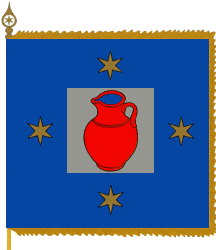 zachary harden
zachary harden
Keywords: siauliai | kursenai |
Links: FOTW homepage | search | disclaimer and copyright | write us | mirrors

Last modified: 2023-06-03 by  zachary harden
zachary harden
Keywords: siauliai | kursenai |
Links: FOTW homepage |
search |
disclaimer and copyright |
write us |
mirrors

image by Virginijus Misiunas, 13 February 2010
See also:
The flag and coat of arms of Kursenai were drawn according to
pictures, which was taken from booklet: DISTRICT OF SIAULIAI
AND ITS CONTEMPORARY HERALDRY [LaL02].
Here is information from this book:
"Kursenai - The town of Kursenai is first mentioned in
historical sources in the 16 th century. In greater details it
was described by S. Zajanczkowski, Polish historian, in the 18 th
century in his writing about Zemaitija (Samogitia). According to
the folk etymology the name Kursenai came from the word
"kursis", which means that the settlement was populated
by the Latvians. However, the legend has it that the flood of the
river Venta carried away hay cocks and in the morning the local
people asked each other "Kur sienai?" (Where is hay ?).
In 1523 the first wooden church was built in Kursenai. A new one
built in 1824 was destroyed during WWI. The present church was
built in 1927-1933 under the design by architect S. Gumeniuk.
At the end of the 18th century Kursenai was a trade town and
suffered during the Uprising of 1831. Its growth at the end of
the 19th century is linked with the construction of the railway
Liepoja-Romnai line. In 1897 the number of the population reached
3,189. The development of the town is also linked with the estate
of len type, the only one of such type in Lithuania, which
prospered in the middle of the 19th century. In 1631 Jurgis
Gruzevskis was granted the rights of len (ownership) to the
estate by King Sigismundus Vasa. Its area remained unchanged
since 1564 to 1922. J. Gruzevskis was honoured because of his
service in the fights with Sweden and Russia. 150 farmsteads
belonged to the estate. The prosperity of the estate reached the
peak in 1846 when Edvardas Gruzevskis, owner, concentrated on
catle breeding and dairy produce. Jonas Gruzevskis, owner of the
latter generation, focussed on the maintenance of the estate,
especially of the park.
WWI an WWII were disastrous for both the town and the estate: the
buildings were destroyed, the constructions were burned down, the
bridge through the river Venta was exploded.
Starting with 1915 Kursenai served as the administrative centre
of the county and the district.
In 2001 Kursenai population reached 14,800 and the town became an
unofficial centre of Siauliai District. There are 4 secondary
schools, including a gymnasium, sports and music schools, a
health care centre and a hospital.
Kursenai is famous for its craftsmen especially in ceramics: J.
Paulauskas, V. Damkus, J. Vertelis, B. Radeckas. In 2001 Folk Art
and Crafts Centre was founded in the former estate building.
Kursenai was the native town of many outstanding people: S.
Rastikis, public figure of the Independent Lithuania, artists A.
Gabrenas, K. Kymantaite, B. Lukosius, teacher S. Anglickas, poet
V. Reimeris, folkartist A. Turauskas.
During the years of the national revival the symbol of the State
of Lithuania - the Vytis - was restored (built in 1928, destroyed
in 1947), the monument to priest V. Dambrauskas, masacred in
1941, the monument to commemorate the victims of the Resistence
Movement on the bank of the river Venta and the monument to
commemorate the exiled to Siberia in the railway station square,
the Cross to the exiled in St. John the Baptist church yard were
erected.
Kursenai is located 22 km to the north west from Siauliai on the
banks of the river Venta by the highways and railway
Siauliai-Klaipeda and Siauliai-Mazeikiai lines. Its territory is
1192 ha.
Kursenai never had a coat of arms. The Heraldry Commission took
into consideration the specificity of the locality, historical
events of the past and the profiles of the most outstanding
people.
In this way L. Ivinskis' personality and his activities were
considered. L. Ivinskis, known as a 19th century enlightener,
educator and publisher of books and calenders - almanac
"Metu skaitlius" ("Counting of the Year"),
spent his last years in the village of Milvydai, close to
Kursenai, and was burried in Kursenai. In 1960 the monument to L.
Ivinskis was erected in the city centrai square. In 1996 the
Museum of Calenders was opened. In the 19 th century his
calenders carried a lot of Information on astronomy and the
natural sciences. Knowledge of astronomy was based on the
observation and analysis of celestrial objects. The sky and the
folk calender are two interrelated topics.
Ceramic works and items from clay produced by local craftsmen
added to the popularity of Kursenai. The file factory was opened
in 1898, a brick factory a year later. A workshop producing
dishware from clay functioned during the years of Independence, a
workshop of the "Jiesia" ceramics factory was opened in
1964. Clay jugs became the most popular items produced in the
city.
The Kursenai coat of arms depicts stars and a jug. The shield is
divided into 2 fields, per pale. The dexter side is charged with
5 gold six-pointed stars on a field of azure and the sinister
side with a red jug, its inside blue, on a field of silver.
The Kursenai coat of arms was confirmed by the President of the
Republic of Lithuania on October 24, 1994."
Anon., 24 June 2003
Kursenai (Siauliai District) - Flag proportions 14:15,
fringe is golden, finial is a golden tip with an openwork
6-pointed star and knob.
Virginijus Misiunas, 13 February 2010